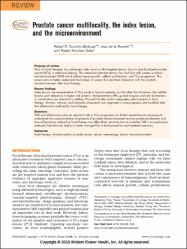Prostate cancer multifocality, the index lesion, and the microenvironment
Künye
Tourinho-Barbosa, R. R., de la Rosette, J. J. M. C. H. ve Sanchez-Salas, R. (2018). Prostate cancer multifocality, the index lesion, and the microenvironment. Current Opinion in Urology, 28(6), 499-505. https://dx.doi.org/10.1097/MOU.0000000000000537Özet
Purpose of reviewMost of focal therapies has addressed index lesion as the targeted tumour focus to treat localized prostate cancer (PCa), a multifocal disease. The interaction between tumour foci and host cells creates a tumour microenvironment (TME) which affects tumour growth, cellular proliferation, and PCa progression. This review aims to better understand the biology of cancer foci and their interaction with the prostatic microenvironment after focal therapy.Recent findingsIndex lesions are representative of PCa grade in low-risk patients, but the other foci of tumour, the satellite lesions, gain relevance in higher risk patients. Multiparametric MRI, guided biopsies and new biomarkers in combination are important to address PCa multifocality and to adequately select patients to focal therapy. Stromal, immune, and tumoural components are integrated in tumourigenesis and modified after the inflammation induced by focal therapy.SummaryTME and inflammation play an important role in PCa progression, but further researches are necessary to understand how once protective components of prostate microenvironment become protumour elements and how inflammation induced by focal therapy can affect them. Learning how to modulate TME is an exploratory molecular field that can lead us to better manage PCa in both prevention and treatment scenarios.


















